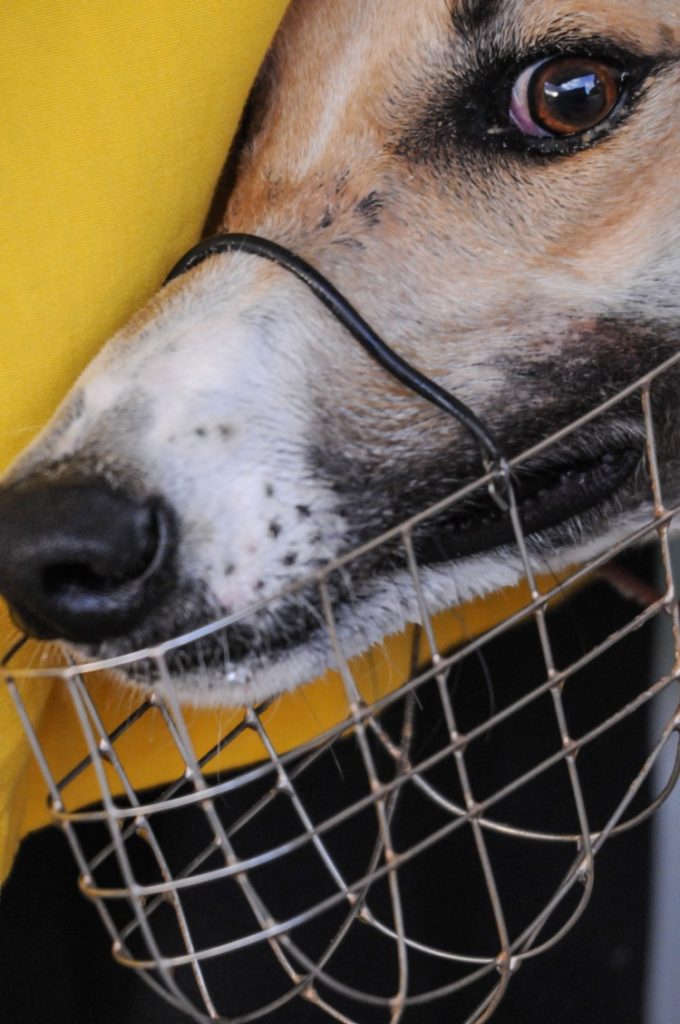July 3, 2019 was a historic day in Chile. The Chamber of Deputies’ Committee on the Environment and Natural Resources approved a draft law on the abolition of greyhound racing. The proposal, adopted by 7 votes in favor, 4 against and 2 abstaining, will now be passed on to the Upper House for approval.

Close-up of a greyhound’s face at a racing facility. The life of a racing greyhound is almost always short and full of suffering. Image credit Jo-Anne McArthur / We Animals.
The bill in question is intended to amend law number 20.380 on animal protection, with the specific aim of prohibiting and punishing the organization of greyhound racing.
Lawyer Maria Celeste Jimenez, animal rights specialist, explains that the commission approved the idea to prohibit greyhound racing by amending article 16 of the law on Animal Protection, on the basis that greyhound racing cannot be considered a sport activity.
Chile would not be the first South American country to prohibit dog racing. In 2016, Argentina passed a law that criminalized greyhound racing. Similarly, last year the government of Uruguay passed a decree ordering a comprehensive ban on dog racing because of the mistreatment of animals.
The decision of the Chilean Chamber of Deputies’ Committee on the Environment and Natural Resources was influenced by a large group of Chilean veterinarians who have recently come out in favor of the prohibition of dog racing. On June 27, 222 of them submitted an official letter to the Chamber of Deputies and the Committee on the Environment and Natural Resources. The statement contained a list of reasons for a total dog-racing ban, including:
- Exhausting physical training to obtain maximum speed and performance. This kind of training is incompatible with animal welfare, such as forcing the dog to run, tied with a string to the back of a motorcycle or pickup. Dogs used for racing have a lower life expectancy, in comparison to members of the same breed who are not involved in racing (2-3 years versus 10-12 years).
- Selection and breeding. In order to obtain a “champion,” it is necessary to make a selection from many dogs. the rest of the dogs who are born are disposed of for being useless. For example, it is estimated that 8,000 dogs are born every year for racing in New South Wales, Australia. Of these, 3,000 are killed for being too slow (Hoetzer, 2015). In the Unites States, 60,000 greyhounds are used for racing annually, while 30,000 of them are killed every year (Atkinson and Young, 2005). The greyhound breed is also characterized by their high risk of bone cancer (Dobson, 2013). Dogs with cancer, of course, do not receive the necessary medical treatment.
- Confinement for a prolonged period. Dogs are regularly locked in cages or left tied to a rope or chain for long periods of time. They are let out only to receive training. Their behavioral and emotional needs are not taken into consideration. The confinement can cause the overproduction of cortisol, a hormone that can weaken the immune system.

Greyhounds in holding pens at a racetrack facility in Australia. This confinement between races is standard in greyhound racing. Image credit Jo-Anne McArthur / We Animals.
- Every single dog used for racing will have many injuries throughout their life. Because of the high impact speed, fractures and traumas can be severe. Expensive and sophisticated techniques would be necessary to treat these injuries. The Chilean veterinarians affirmed that in the exercise of their profession they had to amputate the legs of many dogs due to fall injuries.
- Greyhound racing does not qualify as a sport according to the Chilean Sports Act 19.712. Some examples of sport activities with the participation of dogs are: agility, trekking, disc dog and canicross. In these sports, dogs are trained using rewards and positive reinforcement. This does not happen in greyhound racing. Dogs used for racing are not trained, and immediately after the race they are confined in cages.
- Greyhound racing causes violations of regulation regarding responsible pet ownership within animal protection law number 20.020. Even though the law can be improved, it has led to substantial progress. It foresees, for instance, that the owner of a dog is responsible for their pet’s health, which includes regular veterinary care. Dogs used for racing are subjected to extreme exercise and only rarely undergo medical examination.
In conclusion, the group of Chilean veterinarians consider greyhound racing a practice that “objectifies animals and causes unnecessary suffering.”
Greyhounds are shamelessly exploited wherever they are used for racing. We all hope the draft law will soon become law.
Featured image: greyhounds racing in Australia. Image credit Jo-Anne McArthur / We Animals.





